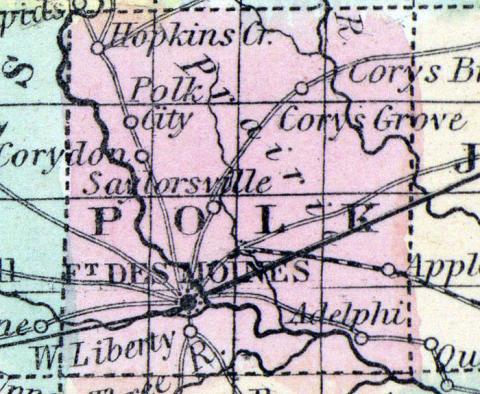POLK COUNTY, situated in the central part of Iowa, and traversed by Des Moines river. Area, ----- square miles. Seat of justice, Des Moines. Pop. in 1850, 4,515. (Fanning's, 1853)
POLK, a county in the central part of Iowa, has an area of 720 square miles. The Des Moines river flows through the middle in a S. E. direction; the Skunk river traverses the N. E. part; and the S. part is drained by Racoon, North, South, and Middle rivers. The soil is highly productive, and well watered. Indian corn and butter are the staples. In 1850, Polk county produced 211,677 bushels of Indian corn; 13,455 of wheat, and 41,058 pounds of butter. It contained 1 church, 2 newspaper offices, and 346 pupils attending public schools. Stone coal is found in several parts of the county. It is liberally supplied with water-power and timber. Capital, Fort Des Moines. Population, 4515. (Baldwin's New and Complete Gazetteer of the United States..., 1854)
POLK COUNTY Was opened for settlement in May, 1846. The garrison was removed in July of that year, and in the same month and year, the town of Fort Des Moines was laid out.
The population of Polk County is upwards of 6000 ; that of Fort Des Moines, 1100.
In the county are Episcopal, Presbyterian (Old and New School), Baptist, Methodist, and Catholic churches — the latter but recently established.
But one newspaper in the county — the " Fort Des Moines Star.''
Two private schools and one public school in Fort Des Moines ; the former in good condition, affording a respect- able academic course for young ladies and gentlemen. A large District school-house, on the ''Union" plan, is in course of erection, to be completed this fall, costing some $6000.
The Des Moines River passes diagonally through Polk County, entering at the north-west and passing out at the south-east corner. Raccoon River empties into this river at Fort Des Moines. Both of these streams afford numerous sites for manufactories and mills. There are several grist and saw-mills in the county, but not a tithe of the number that are needed. Our correspondent writes : "We need more shops of all descriptions, and, above all, manufactories. We want flouring-mills and saw-mills — more of them, and on a larger scale. We want brick-makers, carpenters, cabinet-makers, brick and stone masons, plasterers, and, in short, mechanics of all kinds. We want water-wheels and steam-engines, farmers, machinists, and day laborers.
Polk County, as well as those adjoining, and those farther north and west, is high, rolling prairie, with a due proportion of timber, and is well watered with rivers and creeks, the banks of which abound in coal, lime, sand-stone, and gypsum in great quantities.
The last session of the Legislature located the Capital of the State at Fort Des Moines, since which time that place has been almost besieged by lawyers, doctors, agents, and land speculators.
Fort Des Moines is destined to be one of, if not the, largest interior city in the State.
Of other towns and villages in the county, we would mention Polk City, Corydon, Taylorsville, West Liberty, Circleville, Union, Adelphi, Harvey, Rising Sun, and Jericho. (Iowa As It Is in 1855; A Gazetteer for Citizens..., 1855)

